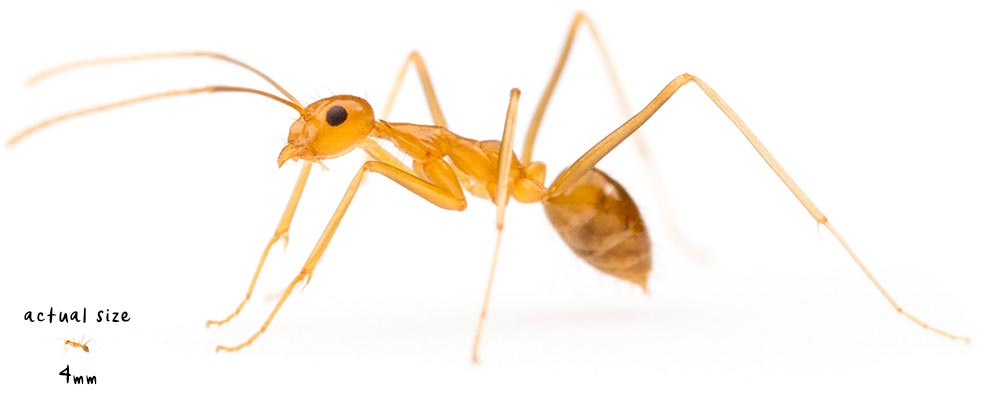Yellow crazy ants (Anoplolepis gracilipes) is one of the largest invasive ant species. They don’t bite people or animals, but they do spray acid from their abdomen. They get their name ‘crazy’ by their fast and frantic movements when disturbed. Yellow crazy ants are a threat to the Wet Tropics environment, local agriculture and our tropical lifestyle.
What are yellow crazy ants?
Yellow crazy ants are one of the world’s worst 100 invasive species (IUCN)
Yellow crazy ants are thought to have originated from Southeast Asia and arrived in Australia by shipping freight. They occur in the Northern Territory, Queensland, Christmas Island and are eradicated in New South Wales.
They arrived in the port of Cairns in 2001 (QLD Government) and spread throughout Queensland including the Wet Tropics World Heritage Area.
Swarms of Yellow Crazy Ants can:
spray acid
harm pets
harm wildlife
harm crops
impact lifestyle
spread rapidly
live in trees
be active 24/7
Yellow Crazy Ants
- have a yellow body and brown abdomen (gaster) that can appear striped when the ant has recently consumed liquid food
- have unusually long legs and antennae
- are 4mm-5mm long
- tend to move in an erratic ‘crazy’ manner, rather than forming distinct trails
- can become highly abundant and have many queens per colony
- can be destructive to the ecosystem and highly invasive
Worker Ants
When we talk about yellow crazy ants, we are referring to the worker ants, Worker ants are:
- Female
- Commonly seen outside of the nest foraging for food
There are also queens and males which are rarely seen outside the nest.
Male Ants
Males are:
- are smaller than workers
- have wings
- are not always visible above ground
- are rarely seen because they do not contribute to colony foraging or maintenance
- sole purpose is mating
Queen Ants
Queens:
- are larger and may have wings
- are responsible for reproduction within the colony
- have a larger abdomen to hold their functioning ovaries
Lifestyle Stages
The development process of yellow crazy ants is similar to butterflies.
- Queens lay eggs
- Eggs hatch after 18-20 days into larvae
- Larvae live for 16-20 days before they turn into pupae
- After 20 days the pupae transform into worker ants
- Worker ants live for about 76-84 days
(Wet Tropics Management Authority, 2020)
Where Do They Live?
The yellow crazy ant is a ground-dwelling species that may also be found in trees and artificially elevated habitats such as houses or machinery.
The ant can be found in natural or man-made habitat. Nests may be found in a wide range of places, for example underground, in leaf litter, in piles of vegetation or rubbish, in tree stumps, in housing or machinery, or almost any dark sheltered space with the right temperature and humidity in which the ants have access to food.
The yellow crazy ant is not typically found in elevations above 1200m (Gruber et al, 2016).
How Do They Spread?
Without human assistance yellow crazy ants have been documented to spread 37m to 402m per year in Seychelles. On Christmas Island, they spread 1100 meters in one year.
Humans are responsible for most of the long-distance spread of yellow crazy ants via movement of colonies or fragments of colonies on agricultural or earthworks machinery or in soil, green waste, or any other infested material.
On their own, colonies typically disperse by ‘budding’, a process where a queen leaves the colony, accompanied by some workers to establish a new nest. In riparian areas spread may also occur if colony fragments are washed downstream when water levels rise after significant rainfall events.
Typically, the budding technique results in a relatively slow rate of dispersal and manageable localised infestations.
Winged yellow crazy ant queens are not known to disperse by flying to new locations.
Impacts Of Yellow Crazy Ants
A video of how invasive species are spread
Social
Farmer Frank Teodo’s experience
Agricultural
Effect on cane and agriculture
Environmental
Invasive ants on the Christmas Islands red crabs
Information Sources
Gruber, M. A. M., Cooling, M., and Burne, A. R. (2016). PIAT: the Pacific Invasive Ant Toolkit. Pacific Biosecurity. New Zealand Ministry of Foreign Affairs and Trade. Available at: http://piat.org.nz (accessed 2019)
Wet Tropics Management Authority. (2020, Feb 24). What are yellow crazy ants. Retrieved from Wet Tropics Management Authority: https://www.wettropics.gov.au/yellow-crazy-ants
Global Invasive Species Database (2020). Downloaded from http://www.iucngisd.org/gisd/100_worst.php on 25-05-2020
Wet Tropics Management Authority. [Minute Earth]. (2014, June 2). Invasion of the Yellow Crazy Ants!. Retrieved from https://www.youtube.com/watch?v=tmztPktOfzs
Invasive Species Council Australia.(2016) What yellow crazy ants can do to Australia’s Wet Tropics. Retrieved from: https://www.youtube.com/watch?v=MKvFAj9gGB8&feature=youtu.be (Accessed: 2019)
Invasive Species Council Australlia. (2016). What yellow crazy ants can do to sugarcane. Retrieved from https://www.youtube.com/watch?v=GoaomEy9lSk&feature=youtu.be (Accessed: 2019)
TheAnimalPortal. (2017). Red crabs and yellow crazy ants (Wildlife Documentary).Retrieved from: https://www.youtube.com/watch?v=viEci2na0p8. (Accessed:2019)
Queensland Government, (2020). Yellow crazy ant. Retrieved May 25, 2020, from
https://www.business.qld.gov.au/industries/farms-fishing-forestry/agriculture/land-management/health-pests-weeds-diseases/pests/invasive-animals/restricted/yellow-crazy-ant





